
A ball is released from rest at the left end of three different tracks. The tracks are bent from pieces of metal of the same length.
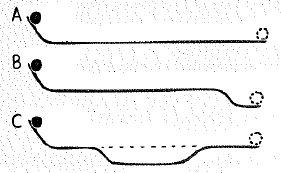
a. From fastest to slowest, rank the tracks in terms of the speed of the ball at the end. Or, do all balls have the same speed there?
b. From longest to shortest, rank the tracks in terms of the time for the ball to reach the end. Or do all balls reach the end in the same time?
c. From greatest to least, rank the tracks in terms of the average speed of the ball. Or do the balls all have the same average-speed on all three tracks?
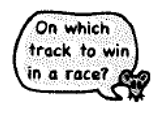
(a)
To rank: The tracks in terms of speed of ball at the end from fastest to slowest.
Answer to Problem 24A
B > C = A
Explanation of Solution
Given:
The three different tracks are shown below.
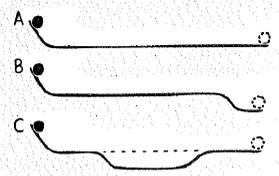
Also, ball is released from rest position.
Formula used:
Assuming there is no friction on the tracks. When the ball is moving on the downfall curve then speed increases due to gravitational force. When it moves its upward curve then speed decreases as the ball has to do work against gravitational force.
Calculation:
On track A, only 1 downward curve is present. So, the ball will gain speed and then moves in constant speed on the straight line.
On track B, there are 2 downward curves present. So, the ball will gain speed with the first one and then after moving for a while in a straight line will again gain speed on the second downfall. Thus, end up with the maximum speed.
On track C, there are 2 downfalls and one upward curve. The ball will first behave as it was on track B and then due to the upward curve, it will work against gravity. Thus, its speed will decrease and ends up with similar speed as the ball has at the end of track A.
Conclusion:
Thus, balls have equal speed on tracks C and A. But, on track B, ball has maximum speed. Hence, ranking will be such as B> C= A.
(b)
To rank: The tracks from longest to shortest in terms of time taken by the ball to reach the end.
Answer to Problem 24A
A> B> C.
Explanation of Solution
Given:
The three different tracks are shown below.
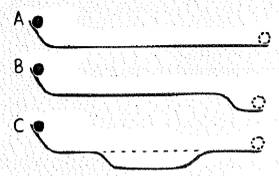
Also, ball is released from rest position.
Formula used:
Time is inversely proportional to speed for a particle for a distance.
Calculation:
Consider track A. The ball in this case will accelerates when it is on the downward curve. After that it travels with a constant speed. Thus, travelling with the constant speed will have the longest time taken of all three.
Consider track B. During each downward curve, the ball will accelerate.This means that it will accelerate twice. So the ball will end up with the higher speed. Falling twice on the downward tracks will have the maximum speed. So, it quickly speeds up and thus lesser time will be taken to reach to the end.
Consider track C. The ball will accelerate twice, but during the upswing segment it will decelerates once. So its velocity on the final segment is same after the dip, as it was before.
C track can be illustrated as shown in the figure below.
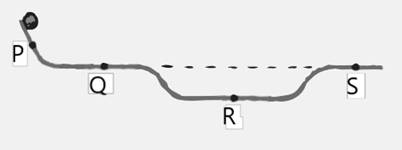
P: slower, but accelerating
Q: faster and constant speed
R:firstly, accelerates and moves with constant speed then decelerates
S: fastest speed equivalent to segment Q
The average speed of the ball will have faster speed as on segment Q. Thus, will take the least amount of time to get to the end.
Conclusion:
Therefore, the rank is A>B> C
(c)
To rank: The tracks in terms of average speed of the ball from greatest to least.
Answer to Problem 24A
Ranks from largest to the least average speed of the ball is as follows C> B> A.
Explanation of Solution
Given:
The three different tracks are shown below.
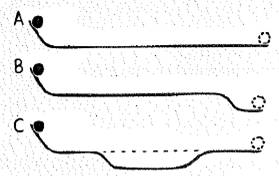
Also, ball is released from rest position.
Formula used:
Average speed is calculated as the total distance travelled on the tracks divided by the time taken.
Calculation:
Time and speed are inversely proportional to each other. So, for longest time average speed will be less in comparison to the shortest time for the same distance.
From part (b), time taken by ball on track C is lowest so the average speed will be highest. While the time taken by ball on track A is highest so the average speed will be lowest
Conclusion:
Therefore, rank of tracks on the basis of average speed is C> B> A.
Chapter 4 Solutions
Conceptual Physics: The High School Physics Program
Additional Science Textbook Solutions
Campbell Biology (11th Edition)
Chemistry: An Introduction to General, Organic, and Biological Chemistry (13th Edition)
Microbiology with Diseases by Body System (5th Edition)
Chemistry & Chemical Reactivity
Genetic Analysis: An Integrated Approach (3rd Edition)
Applications and Investigations in Earth Science (9th Edition)
- Part A You want to get an idea of the magnitude of magnetic fields produced by overhead power lines. You estimate that a transmission wire is about 12 m above the ground. The local power company tells you that the line operates at 12 kV and provide a maximum of 60 MW to the local area. Estimate the maximum magnetic field you might experience walking under such a power line, and compare to the Earth's field. [For an ac current, values are rms, and the magnetic field will be changing.] Express your answer using two significant figures. ΟΤΕ ΑΣΦ VAΣ Bmax= Submit Request Answer Part B Compare to the Earth's field of 5.0 x 10-5 T. Express your answer using two significant figures. Ο ΑΣΦ B BEarth ? ? Tarrow_forwardHo propel 9-kN t. Boat 27. An elevator accelerates downward at 2.4 m/s². What force does the elevator's floor exert on a 52-kg passenger?arrow_forward16. 17 A CUIN Starting from rest and undergoing constant acceleration, a 940-kg racing car covers 400 m in 4.95 s. Find the force on the car.arrow_forward
- ----- vertical diste Section 4.6 Newton's Third Law 31. What upward gravitational force does a 5600-kg elephant exert on Earth?arrow_forward64. Two springs have the same unstretched length but different spring constants, k₁ and k₂. (a) If they're connected side by side and stretched a distance x, as shown in Fig. 4.24a, show that the force exerted by the combination is (k₁ + k₂)x. (b) If they're con- nected end to end (Fig. 4.24b) and the combination is stretched a distance x, show that they exert a force k₁k2x/(k₁ + k₂). www (a) FIGURE 4.24 Problem 65 www (b)arrow_forward65. Although we usually write Newton's second law for one-dimensional motion in the form F =ma, which holds when mass is constant, d(mv) a more fundamental version is F = . Consider an object dt whose mass is changing, and use the product rule for derivatives to show that Newton's law then takes the form F dm = ma + v dtarrow_forward
- If a proton is located on the x-axis in some coordinate system at x0 = -3.2 x 10-5 meters, what is the x-component of the Electric Field due to this proton at a position x = +3.2 x 10-5 meters and on the x axis as the y-axis is 0 giving a number of Newtons/Coulomb?arrow_forwardConsider a single square loop of wire of area A carrying a current I in a uniform magnetic field of strength B. The field is pointing directly up the page in the plane of the page. The loop is oriented so that the plane of the loop is perpendicular to the plane of the page (this means that the normal vector for the loop is always in the plane of the page!). In the illustrations below the magnetic field is shown in red and the current through the current loop is shown in blue. The loop starts out in orientation (i) and rotates clockwise, through orientations (ii) through (viii) before returning to (i). (i) Ø I N - - I N - (iii) (iv) (v) (vii) (viii) a) [3 points] For each of the eight configurations, draw in the magnetic dipole moment vector μ of the current loop and indicate whether the torque on the dipole due to the magnetic field is clockwise (CW), counterclockwise (CCW), or zero. In which two orientations will the loop experience the maximum magnitude of torque? [Hint: Use the…arrow_forwardPlease help with calculating the impusle, thanks! Having calculated the impact and rebound velocities of the ping pong ball and the tennis ball calculate the rebounding impulse: 1.Measure the weight of the balls and determine their mass. Tennis ball: 0.57 kg Ping Pong Ball: 0.00246 kg The impulse, I, is equal to the change in momentum, Pf-Pi. Note the sign change, i.e., going down is negative and up is positive. The unit for momentum is kg-m/s. The change is momentum, impulse, is often givens the equivalent unit of N-S, Newton-Secondarrow_forward
- 5. Three blocks, each with mass m, are connected by strings and are pulled to the right along the surface of a frictionless table with a constant force of magnitude F. The tensions in the strings connecting the masses are T1 and T2 as shown. m T1 T2 F m m How does the magnitude of tension T₁ compare to F? A) T₁ = F B) T₁ = (1/2)F C) T₁ = (1/3)F D) T₁ = 2F E) T₁ = 3Farrow_forwardUsing Coulombs Law, what is the magnitude of the electrical force between two protons located 1 meter apart from each other in Newtons?arrow_forwardCalculate the magnitude of the gravitational force between 2 protons located 1 meter apart from each other in Newtons using Newton's Law of Universal Gravitation.arrow_forward
 College PhysicsPhysicsISBN:9781305952300Author:Raymond A. Serway, Chris VuillePublisher:Cengage Learning
College PhysicsPhysicsISBN:9781305952300Author:Raymond A. Serway, Chris VuillePublisher:Cengage Learning University Physics (14th Edition)PhysicsISBN:9780133969290Author:Hugh D. Young, Roger A. FreedmanPublisher:PEARSON
University Physics (14th Edition)PhysicsISBN:9780133969290Author:Hugh D. Young, Roger A. FreedmanPublisher:PEARSON Introduction To Quantum MechanicsPhysicsISBN:9781107189638Author:Griffiths, David J., Schroeter, Darrell F.Publisher:Cambridge University Press
Introduction To Quantum MechanicsPhysicsISBN:9781107189638Author:Griffiths, David J., Schroeter, Darrell F.Publisher:Cambridge University Press Physics for Scientists and EngineersPhysicsISBN:9781337553278Author:Raymond A. Serway, John W. JewettPublisher:Cengage Learning
Physics for Scientists and EngineersPhysicsISBN:9781337553278Author:Raymond A. Serway, John W. JewettPublisher:Cengage Learning Lecture- Tutorials for Introductory AstronomyPhysicsISBN:9780321820464Author:Edward E. Prather, Tim P. Slater, Jeff P. Adams, Gina BrissendenPublisher:Addison-Wesley
Lecture- Tutorials for Introductory AstronomyPhysicsISBN:9780321820464Author:Edward E. Prather, Tim P. Slater, Jeff P. Adams, Gina BrissendenPublisher:Addison-Wesley College Physics: A Strategic Approach (4th Editio...PhysicsISBN:9780134609034Author:Randall D. Knight (Professor Emeritus), Brian Jones, Stuart FieldPublisher:PEARSON
College Physics: A Strategic Approach (4th Editio...PhysicsISBN:9780134609034Author:Randall D. Knight (Professor Emeritus), Brian Jones, Stuart FieldPublisher:PEARSON





